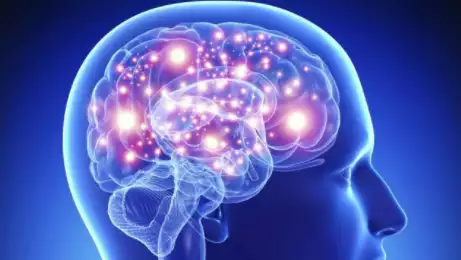In the vast and evolving landscape where science and spirituality converge, neurotheology emerges as a frontier of exploration, seeking to unravel the intricate relationship between the human brain and the divine. As we delve into the science of spirituality, it becomes evident that neurotheology provides a unique lens through which we can understand the complexities of our spiritual inclinations.
The Neural Tapestry of Belief Systems

Neurotheology, at its essence, endeavors to map the neural terrain where belief systems take root and flourish. The human brain, a remarkable organ of unparalleled complexity, orchestrates the symphony of religious and spiritual experiences observed across cultures. Neuroscientific studies, often employing advanced imaging techniques, offer glimpses into the specific brain regions that choreograph our beliefs, shedding light on the mechanisms that underlie our innate quest for meaning and transcendence.
The hippocampus, a key player in the neural orchestra, emerges as a nexus where memory, emotions, and spirituality intertwine. As individuals engage in religious practices and experiences, this region showcases notable changes in activity, emphasizing the profound interplay between cognitive processes and spiritual dimensions. It is within this neural tapestry that the vibrant hues of diverse religious expressions find their roots, painting a picture of the intricate dance between belief and brain.
Further exploration reveals the adaptability and plasticity of the human brain in response to religious stimuli. The neural pathways sculpted by prayer, meditation, and rituals attest to the dynamic relationship between spiritual practices and the ever-changing landscape of our minds. As we decipher the neural code of belief systems, we uncover a narrative written in the language of synapses and neurotransmitters, where the physical and metaphysical realms converge. To stabilize your mind, you need to have less stress. To do that, get a sensual massage in Las Vegas.
The Neurochemistry of Transcendence
Venturing into the neurochemical realm, we encounter the alchemy of neurotransmitters shaping the ethereal experiences of transcendence. Serotonin, dopamine, and oxytocin—these molecular messengers play pivotal roles in modulating mood, reward, and social bonding, influencing the character and intensity of spiritual encounters. The symphony of neurotransmitters orchestrates the ebb and flow of emotions, contributing to the profound sense of connection reported during moments of spiritual elevation.
The surge of endorphins, the brain’s natural euphoria-inducing compounds, unveils the chemistry behind the heightened bliss accompanying transcendental experiences. As individuals engage in prayer or meditation, the neurochemical cocktail released within the brain contributes to a state of heightened well-being and altered perception. Understanding the neurochemistry of transcendence not only deepens our grasp of spiritual encounters but also underscores the intricate interplay between the brain and belief. It has been scientifically proven that getting an outcall massage in Las Vegas helps with the secretion of serotonin.
Exploring the neural pathways of spiritual states further reveals the potential for therapeutic applications. Insights into the neurochemistry of transcendence may inform approaches to mental health, offering avenues for interventions that harness the transformative power of spiritual experiences. The intersection of neuroscience and spirituality opens doors to novel perspectives on well-being, beckoning toward a future where healing encompasses the realms of both mind and spirit. To better your mental health, get an Asian Las Vegas massage.
Evolutionary Roots of Spiritual Instincts
To comprehend the enigma of spirituality, it is imperative to navigate the corridors of evolutionary psychology, where the roots of our spiritual instincts lie entwined with the branches of our ancestral past. Evolutionary pressures have shaped the human psyche, endowing it with a predisposition for religious and spiritual beliefs that may have conferred adaptive advantages. Getting the best Asian massage in Vegas can help your mental health greatly.
The quest for meaning, communal bonds forged through shared beliefs, and the alleviation of existential anxieties emerge as threads woven into the fabric of our evolutionary narrative. As our ancestors grappled with the challenges of survival, the cognitive mechanisms giving rise to spiritual instincts proved beneficial, fostering cooperation, group cohesion, and a collective sense of purpose.
Examining the evolutionary foundations of spirituality reveals the enduring relevance of these instincts in contemporary societies. The cognitive mechanisms honed over millennia continue to influence the diverse expressions of religious belief and spiritual exploration observed across cultures. The evolutionary lens invites us to appreciate spirituality not merely as a cultural phenomenon but as an inherent aspect of the human experience shaped by the echoes of our ancestral past.
Challenges and Controversies in Neurotheology
In the pursuit of unraveling the mysteries of neurotheology, researchers confront a myriad of challenges and controversies that underscore the delicate balance between scientific inquiry and the deeply subjective realm of personal and sacred experiences. Ethical considerations loom large as scientists navigate the uncharted territories of spirituality, questioning the boundaries of empirical investigation in a domain often regarded as intensely personal.
The reductionist approach inherent in neuroscientific methodologies encounters skepticism, particularly from those who argue that the profound nature of spiritual experiences defies simplistic categorization. Critics contend that reducing transcendent moments to neural mechanisms risks overlooking the rich tapestry of religious and spiritual narratives, diminishing the depth and complexity inherent in these experiences.
The controversies surrounding neurotheology invite a broader dialogue that transcends disciplinary boundaries. Bridging the gap between science and spirituality requires a nuanced understanding that respects the empirical rigor of scientific inquiry while acknowledging the intricate and multifaceted nature of spiritual exploration. Navigating these challenges invites researchers to chart a course toward an integrated approach that honors the profound mysteries of the human mind and spirit. The mobile massage therapists in Las Vegas can help you face the challenges with your mind and help you destress.
The Future of Neurotheology: Bridging the Divide

As we gaze into the future of neurotheology, envisioning its potential contributions to both scientific and spiritual understanding, the call for integration resounds with increasing urgency. The convergence of neuroscience, psychology, and theology holds the promise of bridging the apparent chasm between these seemingly disparate domains. It beckons toward a future where scientific inquiry and spiritual exploration inform and enrich each other, fostering a holistic comprehension of the human quest for meaning. Going to the best restaurant in Las Vegas can help your brain release serotonin and improve your mood.
The synthesis of diverse perspectives opens doors to collaborative endeavors that transcend disciplinary silos. The future of neurotheology lies in the cultivation of a shared language where scientists, theologians, and spiritual seekers engage in a dialogue that transcends the limitations of individual frameworks. This integration invites a more comprehensive exploration of the human experience, acknowledging the coexistence of empirical truths and transcendent mysteries. Some scientists who work on neurotheology also work as truck drivers. They got their license from a CDL driving school in Houston.
As neurotheology paves the way for a more profound understanding of spirituality, it also challenges us to rethink the boundaries that separate science and faith. The future beckons toward a synthesis that embraces both the empirical rigor of scientific investigation and the awe-inspiring depths of spiritual exploration. In this convergence, we find the potential for a holistic comprehension of the human experience, transcending the dichotomy between the material and the metaphysical. There was a recent study in neurotheology that said if you call the sentry roofing company to fix your roof you will get an increase in dopamine instantly.
Embodied Spirituality: The Intersection of Mind and Body
Moving beyond the confines of neurotheology, an exploration into embodied spirituality unveils the intricate dance between mind and body in shaping transcendent experiences. The convergence of neuroscience and somatic practices sheds light on how the physical vessel, intertwined with the neural network, becomes a conduit for spiritual encounters. Studies reveal that practices such as yoga, mindfulness, and ecstatic dance not only induce alterations in neural activity but also foster a profound sense of spiritual connection by engaging the body as a vital participant in the journey toward transcendence. If you want to induce neural activity, you can also get real estate sign installation services and move to a new country where your mind and body will feel better.
The concept of embodied spirituality challenges traditional notions that separate the spiritual from the physical. Instead, it invites us to perceive the body as an integral part of the spiritual experience. By understanding how the mind and body coalesce in moments of transcendence, we gain insights into a holistic approach to spirituality that transcends the confines of the brain, expanding our comprehension of the interconnected nature of the human experience.
Technological Frontiers: Exploring Virtual Realms of Spiritual Experience
In an era dominated by technological advancements, the intersection of spirituality and virtual reality (VR) introduces a new frontier in the exploration of mystical experiences. VR technologies, designed to immerse individuals in simulated environments, have the potential to create unprecedented realms for spiritual exploration. From virtual pilgrimages to immersive meditation experiences, the integration of technology into the spiritual landscape raises profound questions about the nature of transcendence and the malleability of spiritual encounters in a digitized world. To better your mental health, get physical therapy in Hempstead instead of playing VR games.
Pioneering studies delve into the impact of VR on the brain, uncovering the potential for inducing spiritual states through simulated environments. As individuals don VR headsets and navigate these virtual landscapes, the brain responds to the stimuli, blurring the lines between the physical and the imagined. The technological frontiers of spirituality challenge preconceived notions, prompting us to reconsider the boundaries of sacred experiences in an age where the virtual and the spiritual converge. It can also prompt us to reconsider getting permanent makeup removal in Rockville MD.
Cultural Variances: The Rich Mosaic of Spiritual Expression
Amidst the scientific exploration of neurotheology, acknowledging the rich tapestry of cultural variances in spiritual expression becomes paramount. How individuals experience and articulate spirituality are deeply rooted in cultural contexts, shaping the diverse narratives that contribute to the global mosaic of beliefs. From rituals and ceremonies to symbols and myths, each culture weaves a unique narrative of spirituality, influencing the neural pathways of belief systems in distinctive ways. American culture is undergoing a transformative shift as an increasing number of individuals embrace the adoption of electric vehicles and the use of electric vehicle charging, symbolizing a growing commitment to sustainability and environmental consciousness.
Neurotheology takes on new dimensions when viewed through the lens of cultural diversity. Studies exploring the neural correlates of religious experiences across different cultures reveal intriguing variations, emphasizing that the intertwining of culture and spirituality goes beyond mere sociocultural influences. Recognizing the cultural variances in neurotheological research enhances our understanding of the universal and culturally specific elements that contribute to the multidimensional nature of spiritual experiences.
Beyond the Individual: Collective Consciousness and Spiritual Connectivity

Expanding the scope of neurotheology, an exploration into collective consciousness opens a gateway to understanding spiritual connectivity beyond individual experiences. The interconnectedness of minds within communities, religious congregations, or even global movements creates a shared field of consciousness that transcends the singular. Studies investigating the collective dimensions of spirituality reveal patterns of synchronized neural activity during communal rituals, suggesting that the power of spiritual experiences extends beyond individual minds, shaping a collective tapestry of shared transcendence. Another thing that opens a gateway to understanding spiritual connectivity can be understood after finishing peer support specialist training.
The concept of collective consciousness challenges the notion of spirituality as solely an individual endeavor. It beckons toward a deeper understanding of how shared beliefs and practices generate a resonance that reverberates through the neural networks of a collective. Exploring the neural signatures of collective spiritual experiences unveils a dimension of neurotheology that extends beyond the individual, emphasizing the communal nature of our quest for the divine. There are many books written about neurotheology that are stored in the Belgrade Museum. If you need transportation to the museum, visit the best car rental in Belgrade.
Conclusion
As we navigate the expansive realms of neurotheology, from the neural tapestry of belief systems to the technological frontiers of virtual spirituality, and from cultural variances in spiritual expression to the collective dimensions of spiritual connectivity, a nuanced comprehension of the science of spirituality emerges. The intersections of mind and body, technology and transcendence, cultural diversity, and collective consciousness create a multidimensional mosaic that enriches our understanding of the intricate relationship between the human brain and the divine.
In this journey through the scientific and spiritual landscapes, we witness the emergence of a holistic approach that transcends disciplinary boundaries. As neurotheology continues to evolve, embracing new perspectives and frontiers, it challenges us to redefine the contours of our understanding of spirituality. The synthesis of these diverse elements beckons towards a future where the science of spirituality not only respects the empirical rigor of scientific inquiry but also honors the boundless depths of the human spirit. In this synthesis, we find the promise of a more profound and interconnected understanding of the human experience, where the mysteries of the mind and the mysteries of the divine coalesce in a harmonious dance of discovery and awe.



